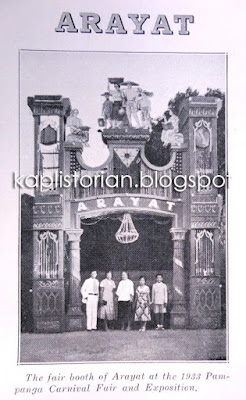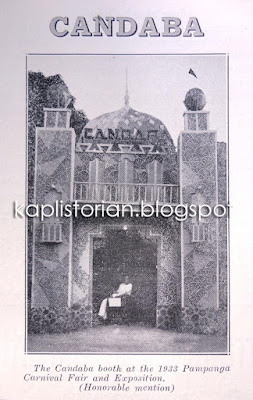The use of short descriptive phrases--sobriquets, nicknames, monickers-- to describe places goes a long way back in history. "Pearl of the Orient" (Perla del Oriente) was first used in 1571 for Manila, now used as a sobriquet for the whole country. Central Luzon, which includes Pampanga, was dubbed as the "Rice Granary of the Philippines". Pampanga, of course, lays claim to the title of "Culinary Capital of the Philippines". Not all place nicknames, however, are positive in nature-- some are insulting, some amusing, many hilarious --but this naming tradition lives on today. Recently, town mottos, too, are being appended to rally people to support their municipality's vision/mission.
**********
ANGELES CITY
Angeles earned its reputation
as a center of entertainment with the rise of its barangay, Balibago as a
recreation and leisure hub for serving both American and local patrons. The
city’s proximity to Clark Air Base jumpstarted the establishments of night
clubs, pubs, bars and gambling dens which lined the main avenue of Balibago, as
well as the nearby perimeter roads known as Fields and Friendship Avenue. The
entertainment strip was lit with neon marquees with Las Vegas inspired names
such as Copa Cabana, Nina’s Papagayo, Little brown Jug, and Tropicana. Like Los
Angeles, it was dubbed as the “City of Angels”, as it was named for both the
founder (Angel Pantaleon de Miranda) and titular patrons (Los Angeles Custodios). The Casino Filipino, run by PAGCOR, is also
located in Balibago.
“Abe-abe…Saup-saup…Agyu Tamu!” (Together...Helping Each Other...We Can!)
APALIT
Apalit is the last town of Pampanga as one goes south to
Manila, hence its nickname. The town is also famous for its long tradition in blacksmithing,
and the best bolos are said to come from
Apalit. Today, th town doe not only produce bladed weapons like machetes and knives,
but also domestic steel tools like rakes, hoes, anvils, picks, shovels and
garden implements.
“Aplit…Apalit!” (Quicken the Pace...Apalit!)
BACOLOR
Like the ancient capital of Greece—Athens—Bacolor
was the undisputed seat of arts and culture of the province, with the highest
concentration of poets, artists, zarzuela performers, musicians, singers and writers.
Bacolor is the proud home of such literary greats as Juan Crisostomo Soto, Felix Galura, Luisa
Gonzaga de Leon, Jose Gutierrez David, Mariano Proceso Pabalan Byron, Anselmo
Fajardo, Zoilo Hilario, among others. Bacolor was also the country’s capital
for two years during the Spanish colonial times when Manila was invaded by the
British.
“Pluribus Unum, Non Plus
Ultra" (Out of Many, No Further and Beyond)”
CAPAS
Capas is one of the richest,
most historic towns of Tarlac, the final
site of the infamous Bataan Death March. It is a trekkers’ and mountaineers’ paradise
as the challenging Mount Pinatubo treks were first offered by this town, which today
continues to attract thousands of
tourists every year, unprecedented in number. This accounts for its latest
nicknames as Tarlac’s tourism capital.
"Paspas..Capas!" (Make Haste, Capas!)
DAU
Camp Stotsenburg established its
Post Exchange in Dau, which presaged its
rise from a barrio of Mabalacat to the country's
PX capital in the 70s. With the relaxation of Clark rules, PX goods flowed out
of the base in abundance, to be resold later in stores that quickly sprouted like mushrooms along
MacArthur Highway of Dau. The completion of the North Expressway that linked
Dau to Manila facilitated the great American experience as visitors trooped to
Dau to buy Pringles, Oreos, Kellogg’s Corn Flakes, Hershey’s Chocolates, Almond
Rocha, Hanes and Fruit of the Loom shirts, imported rubber shoes, branded
cosmetics, apples and grapes, among others. The reversal of fortune began with
the departure of American servicemen facilitated by the Pinatubo eruption of
1991. Business took a turn for the worse when PX Clubs opened at Clark-which
extended PX shopping privileges to Filipinos. Today, Dau shops continue to flourish, with
toilet fixtures, military uniforms, various tools, and used surplus items
replacing the once in-demand PX goods.

FLORIDABLANCA
The third largest municipality in
the province has so much potential waiting to be untapped that the municipal government
came up with a kilometric monicker for the province that reads more like a
vision.
“Abe-abe king Panyulung!” (Together in Advancement)
LUBAO
The ancient town of Lubao (old
name: Baba) has the sole distinction of producing two presidents: Diosdado
Pangan Macapagal (b. Sep. 28, 1910/d. Apr. 21, 1997), who served from 1961-1965
as our ninth President, and daughter Gloria Macapagal Arroyo ( b.Apr. 5, 1947
), who was our 14th President, from 2001
until 2010.
MABALACAT
Over 97% of Clark Economic Zone
is on Mabalacat land, hence the claim as Clarks economic breadbasket. ‘Makati
of the North’ is a monicker coined by the long-running Morales Administration,
which came across as too pretentious. The only similarity is, like the Binays
of Makati, Morales’ term was a long one, stepping down only 2017, after 22
years in power. The Kamikaze monicker is in reference to the Divine Wind suicide
attacks of Japan that was planned in the home of local Mabalacat resident, Marcos Santos, during the last years of World
War II.
“Misanmetung, Mabalacat! (United for once, Mabalacat!)
MACABEBE
In the art of peddling, perhaps
no one can compare to the selling skills of the Macabebe cloth vendors. In
fact, Macabebe takes pride in being called “Home of the Peddlers”, a reputation
built by these native vendors who roamed across the Archipelago, travelling on
foot and in groups of two or more, selling the famous ‘Macabebe
cloth’—actually, Manila-bought fabrics. These humble, hardworking cloth vendors
infused a lot of money into their town and in the 1930s, were largely
responsible for pumping up Macabebe’s economy.
"Memalen Macabebe, tapat
makiabe!" (Macabebe townfolks are loyal friends)
MAGALANG
Magalang aspires to become the
sweet tamarind capital of the Philippines through a locally-propagated tamarind
variety known as Aglibut. The late Professor Andres Aglibut, a consultant of
Pampanga Agricultural College, successfully developed a sampaluk type noted for it sour-sweet taste and
juicy dark brown flesh. This is in consonance with the town’s “farm tourism”
program which aims to revitalize the farm industry of this scenic, agricultural
town.
“One Magalang! Metung King
Panyulung!” (One Magalang, One in our Stride to Progress)
MINALIN
The town is known as the
"Egg Basket of Central Luzon" because of its large scale production
of eggs and chickens. According to the municipal government, Minalin earns P30
million per month or P1 million per day from the sales of eggs. There are 22
poultry raisers who own around 280,000 chickens. These chickens produce 479,100
eggs per day. So important is this egg industry that a laying chicken is even included
in its town seal.
SAN FERNANDO
The capital city of San
Fernando is popularly known as the "Christmas Capital of the
Philippines" because of its traditional giant Christmas lantern industry.
The establishment of the Paskuhan Village in 1990 served to reinforce its
image, but the lantern-shaped complex folded up after the Pinatubo eruption and
fell into disarray. Its Giant Lantern Festival held every December remains the
city’s biggest attraction, in which the city’s barangays field their biggest
and brightest lantern in a friendly competition attended by thousands of local
and international tourists.
SAN LUIS
San Luis’ most famous son is
the Huk Supremo, Luis Mangalus Taruc, who was born in the barrio of sta.
Monica, of peasant parents on June 21, 1913. Following the Japanese invasion,
Taruc formed the Hukbalahap (Hukbo ng Bayan Laban sa Hapon), along with Casto
Alejandrino and other guerillas, in central Luzon in 1942. San Luis became one of the hotbeds of Huk
activities in the 50s and 60s. in 2017, Taruc was recognizedas a hero by the
National Historical Commission of the Philippines (NCHP) for his role the struggle
for agrarian reforms.
SANTA RITA
Sugarcane was the cash crop
that made Pampanga so rich, Sta. Rita included. The town is famous for its
sweet delicacies-- turrones de casuy (wafer paper-wrapped cashew nougats) and
sans rival (rich pastry made with layers of buttercream, meringue, and chopped
cashew nuts). Ocampo-Lansang made these treats famous, and which in turn, gave
the town’s nickname.
“Sesen taya ing Santa Rita” (Let's care for Sta. Rita)
SANTO TOMAS
Santo Tomas is the smallest
town of Pampanga but it has many unique homegrown industries like red clay
pottery and funeral casket-making. The latter products are known for their
beauty and fine quality, made by craftsmen
from about 100 registered enterprises, not to mention 200 backyard producers. Its nickname as the casket capital of the
country was given by the Department of Trade and Industry (DTI) in the 1980s,
and its reputation shows no sign of waning. It is estimated currently, that 40%
of the town depends on the coffin-making industry. It has been the tradition of
Sto. Tomas town to donate coffins to affected provinces during times of
calamities.
SOURCES:
Dau: Photo by Jun Malig, Inquirer Central Luzon
Photo: by Chris Navarro,















































